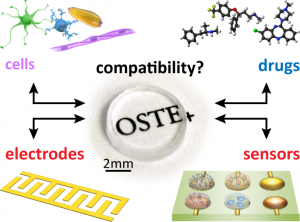Neurovascular Models
We are exploring non-traditional materials and fabrication methods in building the microphysiological systems central to our other research areas.

Organ-on-Chip models are largely enabled by and rely on established microfluidics research fabrication experience, which is dominated by PDMS due to ease of prototyping, low cost, etc.. Regarding microphysiological systems, however, the materials' strong ab- and adsorbtion of hydrophilic molecules (a class including many pharmaceuticals, particularly CNS-targeting ones) presents a significant limitation. Moreover, its dynamic surface presents challenges regarding integration with other materials such as cell-adhesion coatings, pemeable membranes, or sensors.
We are investigating multiple materials and fabrication approaches for next-generation systems. We are collaborating with Merce Labs on employing their facile polymers as structural materials in microphysiological systems of the neurovascular unit (NVU). Furthermore, we are exploring "tape microfluidics" as an entirely different fabrication approach, relying on laser/plotter cutting instead of micromolding. Such approaches with non-traditional materials can variously facilitate simpler systems integration, lower the barriers to entry into the field and more.
